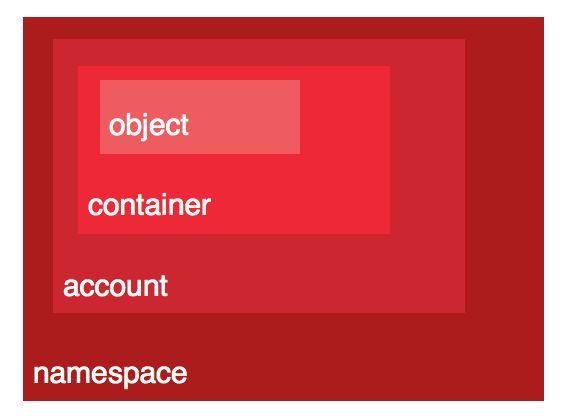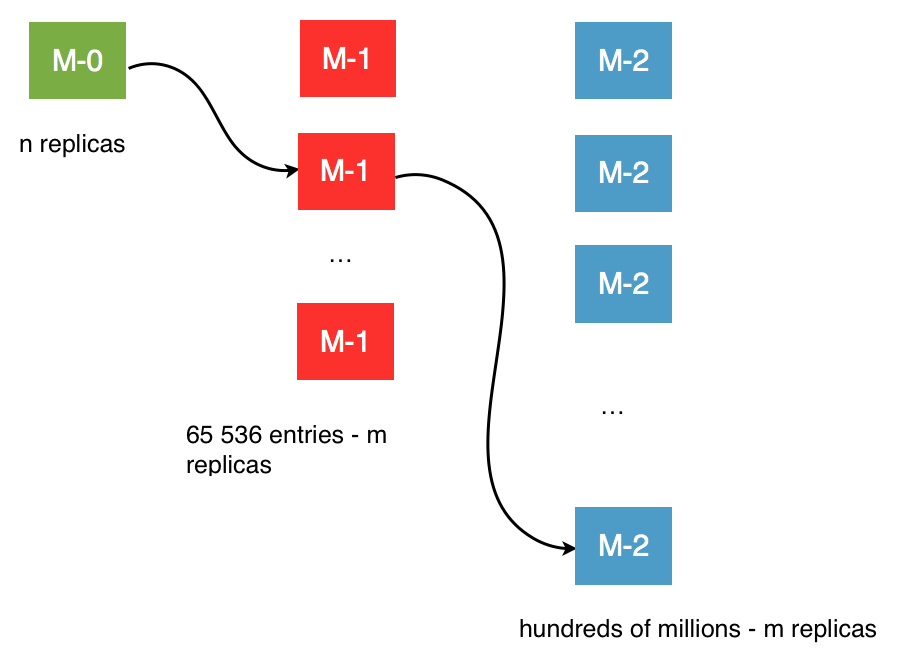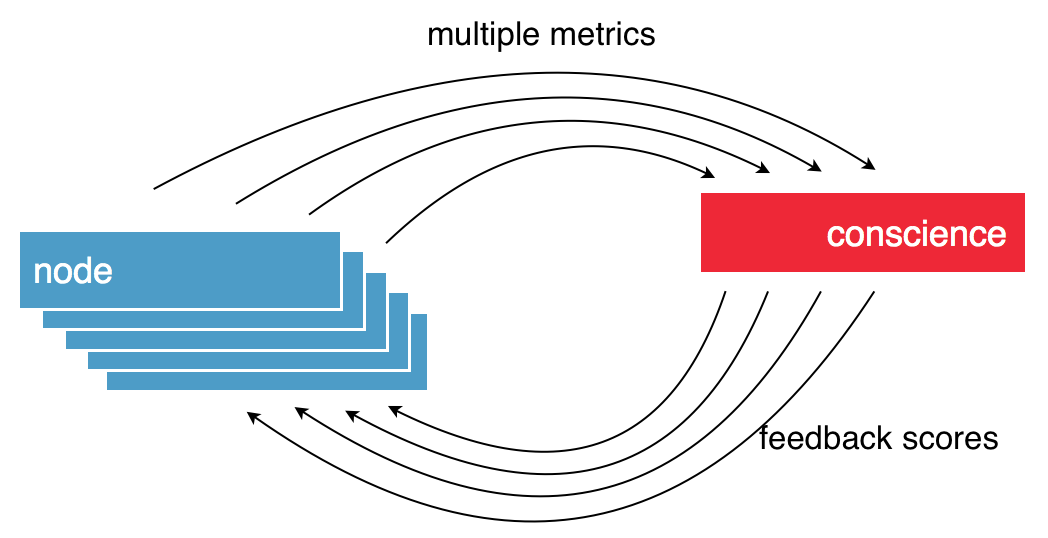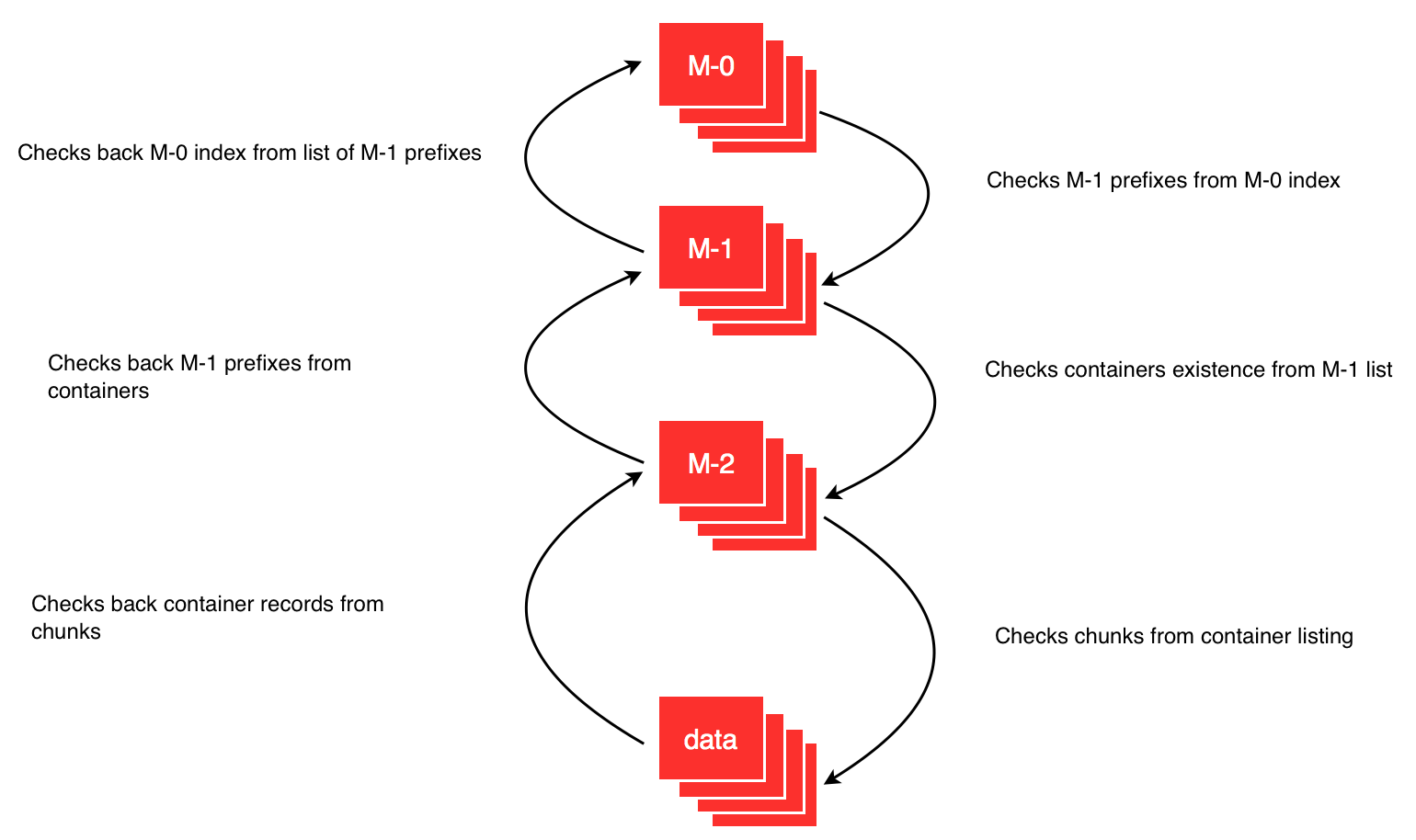OpenIO SDS: Core Concepts
Learn how OpenIO SDS is internally organized, the core notions and components of the on-premises software-defined object storage.
Data organisation

- Namespace: A coherent set of network services working together to run OpenIO’s solutions.
- Account: This usually represents a customer, and there is no limit to the number of accounts in a namespace. Accounts keep track of namespace usage for each customer (i.e. the list of containers and the number of bytes occupied by all of a customer’s objects).
- Containers: These are object buckets, and they keep track of object locations. A container belongs to one (and only one) account.
- Objects: The smallest data units visible by customers. An object belongs to one (and only one) container.
Chunk of objects
Chunks are parts of objects that are limited in size. The chunks are immutable and persisted on the storage devices (either HDD or SSD) and they are not visible by customers.
Their purpose is to fit any very large object into a set of device that could not hold that object at once. With chunking you litteraly get rid of full disks and only consider full namespaces.
OpenIO SDS considers the chunking of the original object the meta-chunks. The key difference between metachunks and actual chunks is that a data security policy is applied on the metachunks to produce the chunks. That data security can be either a plain replication (cf. Replication) or the enforcement of an erasure coding algorithm (cf. Erasure Coding).

Object Versioning
A container can keep several versions of an object. This is configured at the container level, for all objects it contains. The setting is activated when the container is created or during the container’s life.
When versioning is disabled, pushing a new version of an object overwrites the former version, and deleting an object marks it for removal. When versioning is enabled, pushing an object creates a new version of the object. Previous versions of an object can be listed and restored.
The semantics of object versioning has been designed to be compliant with both Amazon S3 and Swift APIs.
No SPOF
Each service used to serve data is redundant. From the top level of the directory to the chunk of data stored on disk, all information is duplicated. There is no SPOF (single point of failure): a node can be shut down, and it will not affect overall integrity or availability.
Container & Chunk Isolation
Each container is stored in a separate file (i.e. not all in one unique data structure), and each chunk is also stored as a file. This greatly improves the overall robustness of the solution and limits the impact of corruption or the loss of a single item.
Massively Distributed Three-Level Directory
Containers and objects are stored in a persistent three-level distributed directory (Meta-0, Meta-1, Meta-2). OpenIO SDS can store hundred of services for each of hundred of millions of containers, with strong consistency and low latency, especially for read operations. The directory has the form of a hash table, mapping containers’ UUIDs to their services. To handle a large number of items, a first level of indirection splits the hash table into 64k slots. Every level is synchronously replicated.
Higher levels of the directory (indirection tables) are particularly stable, and benefit from cache mechanisms in place. Caches are implemented everywhere, especially inside directory gateways, and are also available on the client side.

References
References are named groups of service links. Internally, their names are hashed to a 64 bytes hexadecimal string. References are managed by the second level of the service directory (Meta1).
Prefixes
Prefixes are the first bytes of hashed reference names. They are used to shard the references on the first level of the service directory (Meta0). In the current implementation, prefixes are 16 bits long, so there are exactly 65,536 of them.
Directory Replication
Configurable at each level of the architecture, directory replication secures namespace integrity. Service directory and container metadata can be synchronously replicated on other nodes.
Each prefix has its own replication cluster. When the prefix is created, the replication cluster is created, and the participating directory servers are selected. Each replication cluster has a single master and a set of slaves: the master manages write operations and replicates them to its slaves. A write operation is considered successful when the replication quorum is respected. Note that slaves can also perform reads if requested.
Transient failures like network partitions can cause replicas to diverge, but with this replication mechanism differences are reconciled automatically.
Conscience: Dynamic Load-Balancing
For data placement, OpenIO SDS provides a system called Conscience, responsible for efficiently matching requests and services. Conscience takes into account constraints set by the request (i.e. respect of storage policies) and computes a quality score between 0 and 100 for each service available in the cluster. These quality scores are based on an algorithm that aggregates data provided by a number of sensors on the various nodes of the grid. Through this feedback loop, each node knows in real time which are the best nodes with the highest scores to handle subsequent requests.
A score of 0 indicates the service must be avoided. A positive score means the service can be used; the higher it is, the better its performance will be.

Reverse directory
The rdir services keep track of all chunks stored on each rawx service. When a rawx is broken, admins can rebuild lost chunks thanks to rdir information, as long as each chunk is duplicated. When a chunk is uploaded to a rawx (or deleted), this rawx sends an event to the event agent, which updates rdir information.
For each chunk, rdir stores:
mtime: the date of the last update of this entry (when a chunk is uploaded to a rawx).rtime: the date of the rebuild, if any.- the
idof the object the chunk belongs to.
If the volume has no associated rdir, an rdir will be automatically associated to it. The Meta1 directory stores this association using the special account _RDIR.
Metadata Proxy
Whichever protocol is in used by internal services (directories), all clients rely on a layer of gateways that provides a simple REST API for metadata accesses. This API provides high-level operations that encapsulate all the underlying logic behind the management of accounts, containers, and their contents. Gateways are also the ideal place for shared cache mechanisms, similar to the way name service cache daemon works on Linux hosts.
Sequence diagram - PUT
Sequence diagram for a simple PUT operation in a container
- Meta-Proxy - Conscience: retrieve all the services available and their scores. This request is done every 5 seconds by default (configurable).
- Meta1 - Meta-Proxy: retrieve all the services, except meta0 and meta1. This request is done every 1 second by default (configurable).
- Meta2 - Meta-Proxy: retrieve all the meta2 & rawx with their scores, the namespace storage policy and the chunk size. This request is done every 1 second by default (configurable).
- SDK Client - Meta-Proxy: call the prepare function with the following parameters: container name, object name, size, storage policy.
- Meta-Proxy - Meta0: Retrieve all Meta1.
- Meta-Proxy - Meta1: Retrieve the Meta2 service managing the container.
- Meta-Proxy - Meta2: Retrieve available rawx to store content with the given storage policy. The meta2 service checks quota
- Meta-Proxy - SDK Client: Return all the rawx (example: 127.0.0.1:6000/ABCD1234).
- SDK Client - Rawx: upload chunks on each rawx previously returned. The rawx service generates events for Rdir services.
- SDK Client - Meta-Proxy: call the create function to validate the creation of the object.
- Meta-Proxy - Meta2: validate all the chunks location. The meta2 service generates events.
Business rules
The Meta2 service apply storage policies in the following order:
- Storage policy in the request header
- Storage policy on the container
- Namespace storage policy
According to the storage policy, the Meta2 returns:
- In cases of replication, N rawx where N corresponds to the number of replicas
- In cases of erasure coding:
- K+M rawx, K and M corresponding to the Erasure coding configuration
- If the object size is greater than the configured chunk size, the number of rawx returned will me multiplicated by the necessary number of chunks
The meta2 generates different events during the chunk creation:
- Events to indicate that the object has been created
- Events to indicate that some chunks could not be created (rebuild queue)
- Events with container statisitics for the Account service.
Self-Healing / Integrity Loop
Each directory has a counterpart that is reversed; i.e., each item knows its parents. A container is aware of its account, and a chunk is aware of the object and the ID of the container it belongs to. This makes it possible to rebuild a directory with a simple crawl of the items present on the storage nodes. Even if a container is lost, it is still possible to reconstruct it directly from the data. Usually, containers are replicated and rebuilt without the need for a reverse directory crawl.
Storage nodes are also periodically crawled to trigger actions on each item (e.g. integrity checks, or chunk accessibility).
All these administrative tasks are accessible through REST APIs, so it is easy to perform on-demand maintenance actions.

Erasure Coding
OpenIO internally uses liberasurecode and allows the administrator to configure the algorithm and its K and M parameters. There are several advantages to this:
- It uses much less disk space, depending on your K and M.
- Reads and writes are parallelized.
- It immediately informs the user if data has been corrupted.
On the other hand, there are some disadvantages:
- It keeps K+M sockets open for each read/write operation.
- It consumes CPU for both reading and writing.
- Raw chunks cannot be used as is.
Replication
Container replication is performed using the same mechanism as service directory replication. Each container has its own replication cluster. The participating container servers are selected when the container is created, and specific service distance constraints are respected.
Object replication is performed at the chunk level. At the time of object upload, chunks are uploaded by the client to the chunk servers in parallel. If one of the chunk servers fails during this operation, the object upload can continue while the replication quorum is respected.
Isolation
Each container is stored in a separate file (i.e. not in one unique data structure), and each chunk is also stored as a file. This greatly improves the overall robustness of the solution and limits the impact of corruption or the loss of a single item.
Multi-Tenancy
Multi-tenancy is a core element of OpenIO SDS. Data is organized in two main levels: the account and the container. Data objects are stored using the following hierarchy: namespace/account/container/object. Multiple namespaces can be configured in each cluster, providing multi-region/zone logical layouts for applications and segregated workloads depending on tenant or data geo-distribution needs. There is no classic subdirectory tree. Objects are stored in a flat structure at the container level. As with many other object storage solutions, it is possible to emulate a filesystem tree, but it has no physical reality.